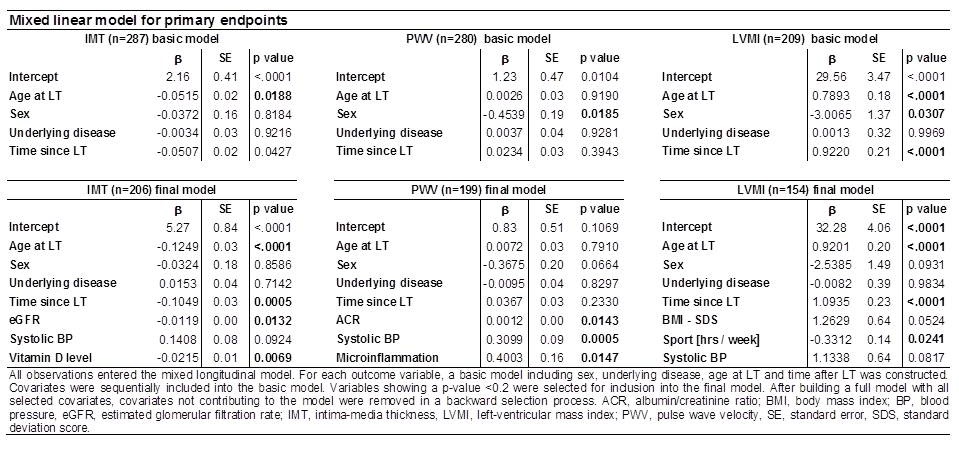Factors Associated with Subclinical Cardiovascular Damage after Pediatric Liver Transplantation: A Longitudinal Observational Study
1Department of Pediatric Kidney, Liver, and Metabolic Diseases, Hannover Medical School, Hannover, Germany, 2Department of General, Visceral and Transplantation Surgery, Hannover Medical School, Hannover, Germany, 3Department of Nephrology and Hypertension, Hannover Medical School, Hannover, Germany
Meeting: 2019 American Transplant Congress
Abstract number: 497
Keywords: Arteriosclerosis, Pediatric, Post-transplant hypertension, Risk factors
Session Information
Session Name: Concurrent Session: Liver: Pediatrics
Session Type: Concurrent Session
Date: Tuesday, June 4, 2019
Session Time: 2:30pm-4:00pm
 Presentation Time: 3:06pm-3:18pm
Presentation Time: 3:06pm-3:18pm
Location: Room 210
*Purpose: Cardiovascular (CV) events account for 8-13% of deaths after liver transplantation (LT) in adulthood. While CV risk factors are present in children after LT little is known about the prevalence of subclinical CV damage.
*Methods: We annually assessed subclinical CV damage by measuring intima-media thickness (IMT, a marker for atherosclerosis), pulse-wave velocity (PWV, signifying arteriosclerosis), and the left-ventricular mass index (LVMI, as parameter for left-ventricular hypertrophy) in 110 pediatric LT recipients (aged 11.4 ± 3.7 years) over a period of 4.6 years in a prospective longitudinal observational study (n=83 for F/U1, n=62 for F/U2, n=35 for F/U3, n=15 for F/U4).
*Results: At inclusion, elevated IMT was present in 59%, elevated PWV in 24%, left-ventricular hypertrophy in 10%. Mixed linear modeling including all observations identified younger age at LT, shorter time since LT, decreased renal function, and low vitamin D levels to be independently associated with IMT, and higher albumin/creatinine ratio, higher systolic blood pressure and the presence of microinflammation for PWV. Older Age at LT, longer time since LT and less physical activity were an independent predictor of higher LVMI.
*Conclusions: Pediatric LT recipients display relevant subclinical CV target organ damage. Apart from immutable factors, such as age at LT, we could identify modifiable risk factors (such as blood pressure, renal disease, hypovitaminosis D) contributing to CV damage that could serve as targets for preventive measures. In light of excellent long-term survival in this patient collective, CV morbidity needs to be addressed.
To cite this abstract in AMA style:
Memaran N, Goldschmidt I, Borchert B, Sugianto RI, Wilke H, Blöte R, Baumann U, Bauer E, Wick Avon, Junge N, Leiskau C, Pfister ED, Richter N, Schmidt BM, Melk A. Factors Associated with Subclinical Cardiovascular Damage after Pediatric Liver Transplantation: A Longitudinal Observational Study [abstract]. Am J Transplant. 2019; 19 (suppl 3). https://atcmeetingabstracts.com/abstract/factors-associated-with-subclinical-cardiovascular-damage-after-pediatric-liver-transplantation-a-longitudinal-observational-study/. Accessed December 10, 2025.« Back to 2019 American Transplant Congress

